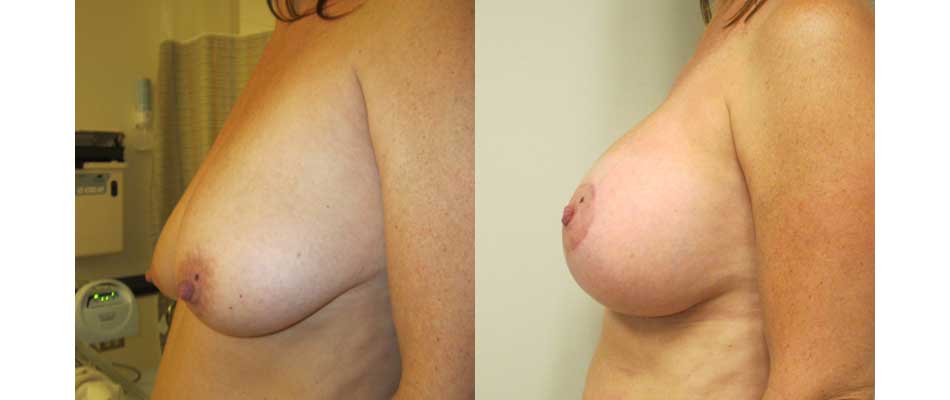Breast Augmentation + Lift
Aging, weight fluctuations, pregnancy, and breastfeeding can affect the shape and volume of your breasts, changing your posture, how your clothes fit, and sometimes how you feel about yourself. A breast augmentation and lift can return your more youthful shape.
What Is a Breast Augmentation And Lift?
Breast augmentation is a popular cosmetic procedure to increase breast size, restore volume, or remodel the shape of the breasts. Breast size is increased with implants or fat transfer from another place on your body.
Augmentation can increase the fullness and projection of your breasts and improve your hip-to-breast proportion, but it can’t lift and firm them. A breast lift, however, can.
A breast lift procedure can change the shape of the breasts by raising and firming them. It can also reposition the nipples and decrease the size of the areola to better fit the lifted breasts. As a standalone procedure, a breast lift can’t increase cup size much or add volume.
A breast augmentation and lift combine both procedures to give you shape, volume, symmetry, and lift – a younger, firmer look.
Who Is a Good Candidate for Breast Augmentation and Lift?
Before scheduling a breast augmentation and lift, you should carefully consider the risks and benefits.
You may a good candidate if you:
- Are concerned that your upper breasts seem flat or have sagged
- Are not pregnant or breastfeeding
- Are physically healthy
- Have fully developed breasts
- Have one or both breasts that did not develop normally
- Have one or both breasts that your nipple has shifted, or areolae stretched
- Have realistic expectations
- Would like to change your breast size, shape, or volume
- Would like your breasts to be more symmetrical
With any breast procedure, you should consider whether you plan to become pregnant or will be breastfeeding in the future. If so, it may be best to wait until afterward for a breast augmentation and lift. Pregnancy may change the size and shape of your breasts, which could change the results if you have a breast augmentation and lift before becoming pregnant.
The Procedure
At your initial consultation, your doctor will review your medical history, complete a physical exam, discuss your expectations, and go over the risks and benefits of surgery. Before having surgery, your doctor may ask you to:
- Schedule a baseline mammogram
- Stop smoking
- Maintain a healthy weight
- Stop taking certain medications temporarily
- Arrange for help at home during your recovery
Your procedure will be in an outpatient center or hospital under general anesthesia or sedation. During the procedure:
- Your surgeon will make incisions in less-visible areas to hide the scarring.
- The implant will be placed in a “pocket” created under or over the pectoral muscle.
- Your surgeon will reshape or reposition breast tissue as discussed in your consultation.
- Then, he’ll close the incisions with sutures and adhesive or surgical tape.
- Your breasts will be wrapped in dressings or support garments to keep swelling down and support the tissue while healing.
- You will rest in a recovery area until you are cleared to go home. Before leaving, your surgeon will talk to you about post-operative instructions and care.
Recovery
You may go home with pain medication, drainage tubes, stitches, dressings, and a compression garment. When you’re cleared to go home, we’ll go over important post-procedure information, like:
- How and when to take pain meds
- Physical restrictions like bending, lifting, or straining
- When you can return to normal activities
- How to care for your dressings, stitches, and drainage tubes
- The importance of sleeping on your back or side and protecting your breasts from pressure
- What signs of infection or other complications you should watch for
- Who to call with questions or concerns
- Your follow-up appointments
It is essential to your healing and to achieving your best results that you carefully follow all of the post-procedure instructions.
You should notice the change in the shape of your breasts at once, but it can take a few months to completely heal and settle into your new shape.
Risks
There is a risk of complications with any surgery. Before we schedule surgery, we’ll explain the risks and answer any questions you may have.
Complications are rare but could include:
- Asymmetry or irregularities in shape and size
- Bleeding
- Breast implant-associated anaplastic large cell lymphoma (BIA-ALCL)
- Changes in sensation
- Damage or tissue loss of nipples or areolae
- Fluid buildup
- Hematoma
- Implant leak
- Implant rupture
- Incorrect positioning
- Infection
- Pain
- Poor scarring
- Reactions to anesthesia
- Tight scar tissue around the implant
- Wrinkling over the implant















